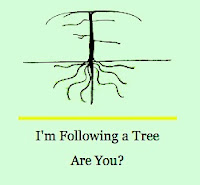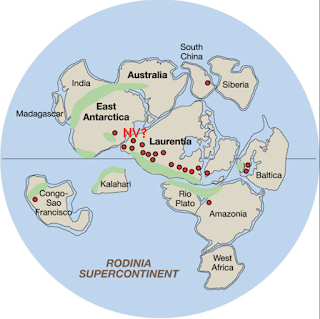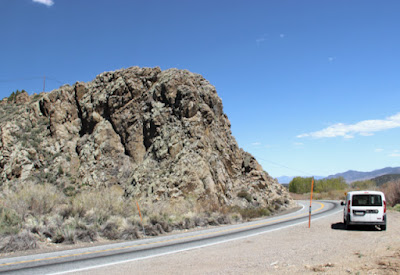 |
| A story of granite, grus, and tors. |
If you wander the summit of the Laramie Mountains as dusk falls, chances are you will spot mysterious creatures silhouetted against the evening sky—giants forever waiting by their castles, life-like but never moving. But if you get too close, they disappear, no matter how stealthily you approach. In their place are peculiar stacked stones and huge rounded masses of rock.
These are our tors (from the Old Welsh "twr" meaning pile or cluster). In shapes ranging from rounded blocks to dancers, turtles, beehives, and potato chips, they inhabit magical places like Vedauwoo, Blair, and the Devils Playground. But why? How and when did such fantastical beings appear?
Pioneering geologist Ferdinand Vandeveer Hayden once admonished humanity for not asking such questions. "Like the ripe fruits which so many pluck from the tree, and enjoy without a further thought, [landscapes] are accepted by mankind, and how few are thoughtful enough to inquire from whence they come!"
But not us, Professor Hayden. We are among the thoughtful few!
Monuments left by erosion, pleasing in their varietyHayden's complaint appeared in his 1871 Preliminary report of the U.S. Geological Survey of Wyoming, specifically in the section about the Laramie Mountains, which he had crossed by train the previous year. At the crest, he came upon "scenery which is quite unique and remarkable, differing in many of its features from that at any other point along the [rail]road."
It was a landscape dominated by granite, as Hayden explained. The plateau-like summit was "literally paved with small fragments", and "massive piles, like the ruins of old castles, are scattered all over ... the difference in texture of the rock is such as to give a most pleasing variety, hardly any of these piles being alike."
Hayden then turned to the difficult question—from whence they come. "There is an interesting thought just here as to the real origin of these granitic, ruin-like piles that give the peculiar distinction to the plateau surface of the Laramie Mountains. I believe it is entirely due to erosive forces, which have operated here on a gigantic scale, and these cones and natural temples are the monuments that are left to tell the tale."
"I am convinced that the surface was at one time at least on a level with the highest of [the granite piles]." he continued. "How much more has been removed it is now impossible to tell, but I am convinced that comparatively few geologists have fairly estimated the immensity of the time required and the vastness of the amount of material removed from the surface by erosion."
Broadly-speaking, Hayden was correct. The tors of the Laramie Mountains were created by erosion. But there's much more to the story. It seems that erosion played multiple roles—shaping, revelation, and now destruction.
 |
| "Skull Rock ... has been peeled off, coat by coat, by the fingers of Time ..." wrote Hayden in 1871. (LOC). |
A granite named Sherman
In early August 1907, the Laramie Republican (newspaper) announced the arrival of a "geological savant"—Professor Eliot Blackwelder, of the University of Wisconsin and the U.S. Geological Survey. He would study the surface geology of the southern Laramie Mountains, specifically the oldest rocks of the range.
For regular readers of this blog, "Eliot Blackwelder" may ring a bell. He appeared in a recent post about the Snowy Range, where he also studied ancient rocks. In fact, Precambrian rocks—the oldest on Earth—were Blackwelder's specialty.
Shortly after arriving, Blackwelder recruited an assistant—Herbert Kennedy, of the Republican's business department (he was replaced by his brother, Leon). Two days later, they left to set up their field camp near Tie Siding. They would work into late September, when Blackwelder returned to Wisconsin and Herbert Kennedy returned to his studies at the University of Wyoming.
In 1908, Blackwelder published "Pre-Cambrian rocks in southeastern Wyoming". He named the granite at the crest of the Laramie Mountains the Sherman granite, after the now-defunct Sherman railroad stop. The next year, in text accompanying geologic maps for the area, he described what he considered "the most important event of pre-Cambrian time in this district ... the intrusion of a vast mass of coarse-grained granite."
Rapakivi and grus—killer conversation starters
Like Hayden, Blackwelder was impressed by the small fragments that covered the ground to great thickness. "Although hard in its unaltered condition the Sherman granite disintegrates readily under the influence of descending surface waters and produces a coarse gravelly soil ... In excavations at Buford the granite has been found to be decayed to a depth of 40 to 50 feet ...".
This would greatly benefit the Union Pacific Railroad. The Buford quarry furnished trackbed ballast for 800+ miles of track, from Omaha to Rock Springs. From 1900 to 1914, an estimated 10,000 railcar loads were produced each year. Furthermore, Sherman ballast was cheap—a ton for just 6¢! —while average cost for the region was 49¢ per ton.
 |
| UPRR track builders approaching crest of Laramie Mountains on a bed of Sherman grus; 1867-68; Beinecke Library (cropped). |
Because it breaks down so readily, geologists classify the Sherman granite as "rapakivi" ("mud rock" in Finnish). If wetted, mica in the granite expands, breaking the rock to create gravel, mainly crystals of feldspar and quartz. Geologists call this kind of decomposed granite "grus" (pr. gruce or sometimes gruss).
Blackwelder all but ignored the other remarkable feature of Sherman granite—the tors. He provided one photo and a single sentence. "Where thus deeply weathered, the outcrops of granite are smoothly rounded and free from visible ledges."
 |
| Sherman granite on crest of Laramie Mountains; looking north across "wide rolling plain of the mountain plateau". From Blackwelder's 1909 report (USGS); photographer unknown. |
The problem of tors
Tors have long been mysterious and difficult to explain. One of the biggest obstacles is the many kinds, which likely differ in origin. Fortunately, the tors of the Laramie Mountains appear to be very similar to those of England, which have preoccupied humans for millennia. Perhaps their accumulated knowledge will provide some insight into the origins of our tors.
 |
| Haytor, perhaps the grandest of Dartmoor tors (southwest England; courtesy Smalljim). |
The earliest accounts invoked mysticism and magic. Often tors were said to be living creatures turned to stone during some foolish encounter with a witch or the devil. A magical explanation for our tors would be wonderful, since the geology is complicated and still debated! But it appears there are none available, so we will rely on science.
English antiquarian and naturalist William Borlese of Cornwall may have been the first scientist to study tors. In a 1758 account, he concluded they were human creations, like the obvious constructions at Stonehenge. This was a popular theory for a time, but then geologists intervened.
Early on, geologists suggested that tors were once sea stacks—isolated stone towers just offshore. But sea stacks are angular and jagged, whereas the tors of England (and the Laramie Mountains) are distinctly rounded.
Need to look in surprising places
In the second half of the 19th century, several English geologists made a conceptual leap. They spotted similar forms, not above ground, but in granite quarries! They realized that tors look very much like the quarryman's rounded "corestones" but with the "growan" (grus) removed. These geologists concluded that tors develop underground, where they wait to be revealed, whether by quarrymen or erosion.
In spite of the remarkable similarity of tors and corestones, this theory was largely ignored until 1955. That year, an English specialist in landforms, geomorphologist David Linton, published a paper explaining a process that could sculpt tors underground—"profound rock rotting." Groundwater flowing through fractured granite can break down narrow zones of rock, creating rounded blocks and filling the cracks with grus.
Profound rock rotting seems a likely explanation for our tors, made as they are from rapakivi granite!
 |
| Stages in the evolution of tors, by subsurface rock rotting (Linton 1955). |
From birth to emergence
By now, readers surely are at the edge of their seats, eager to learn how our tors made it from their subterranean birthplace to the surface. But first we must backtrack 1.43 billion years. That is the estimated age of the Sherman granite, the time when it crystalized from molten magma, the actual birth of our tors.
They may have remained in their infant form for hundreds of millions of years. Geologists still debate when shaping of the tors took place. The granite may have fractured when it solidified. Or maybe it happened later when erosion at the surface reduced pressure on the granite underground. Or maybe both! Nor is it clear when groundwater reached the fractured granite and began breaking it down. And there may have been several episodes.
We have a better understanding of how and when the tors were finally revealed at the surface. Their emergence is related to the Laramide Orogeny—the great mountain building episode that started 80 million years ago, lasted almost 40 million years, and created mountain ranges from Mexico to Canada—the Rocky Mountains.
It was during creation of the Rockies that the Laramie Mountains were uplifted. Like all mountains, as soon as they began to rise, erosion set in. This was erosion on a grand scale, just as Hayden suspected. After about 35 million years, enough overlying rock had been removed to expose the ancient Sherman granite. Grus in the joints was washed away, leaving behind our remarkable tors.
Visit our aging torsErosion hasn't stopped. It continues to slowly expose more tors, but it also destroys the ones we know and love. Wind, rain, and freezing remove a bit more rock every year. Occasionally a block falls! But from our perspective, ephemeral beings that we are, this destruction is incredibly slow. We still have time to enjoy our tors, so let's go!
From Interstate 80 about 15 miles east of Laramie, take the Vedauwoo Road east. Drive a quarter mile beyond the entrance to Vedauwoo Glen (fee area) to a grus-covered parking area on the left (free, with bathrooms). Follow the grus-covered trail past an interpretive sign and Pedestal Rock. Look for low mounds of granite—are these young tors emerging from below? or fallen blocks buried in grus? Curve left uphill and through a gate. Wander to the right across a large slab of Sherman granite. Note crystals of pink and white feldspar, sparkly quartz, and black biotite mica between the patches of lichen. Take in terrific views of tors, pleasing in their variety, just as Hayden said. Explore cracks and gullies to see decomposing rapakivi granite.
The best time to visit is during the golden hour before sunset—the magic hour when the light is warm and soft. You will be tempted to stay longer. But if dusk falls, do take care, lest you too be turned to stone!
 |
| Vedauwoo tors during the golden hour, not long before dusk. |
This post is based on an article I wrote recently for the Laramie Boomerang's "History" column. In case you're wondering, I don't believe in magic ... under normal circumstances.




































